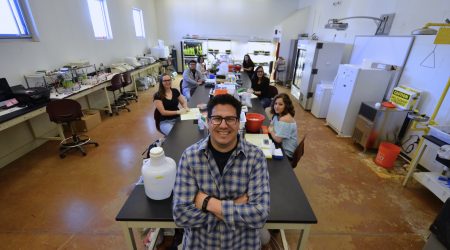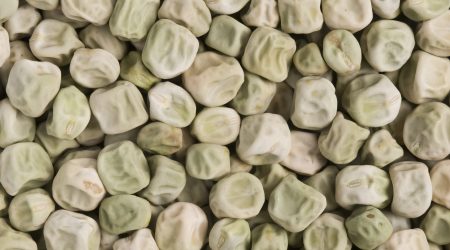To feed a growing population we don’t just need to produce enough food, we need to produce enough nutritious food
Researchers at the John Innes Centre are delving inside plants to boost nutrition in crops and address one of the most pressing global public health challenges we face.
Over two billion people globally suffer from ‘hidden hunger’ or micronutrient deficiencies. This includes diets which lack vitamin A, zinc and iron. Although the body only needs small amounts of these compounds, they are essential to maintain good health and prevent illness. However many symptoms of deficiency are not visible, such as lower resistance to disease and fatigue.
Hidden hunger is most often found in countries where people gain most of the energy in their diets from sources such as cereals, roots and tubers.
As Professor Cristobal Uauy, a wheat geneticist, explains, “One of the problems we have in terms of trying to improve nutrition in crops is that often there is no market. Consumers want nutritious food but they don’t necessarily want to pay more for it. So, who pays for it? Many crop breeding companies don’t aim to improve nutritional value because it’s difficult for farmers to increase their return, then also society won’t pay extra for it.”
Many countries have legislation stipulating certain thresholds of nutrients required in food products.
These are met by adding the nutrient compounds in the processing of foods, known as ‘direct fortification’. This has been shown to benefit public health in some cases, particularly when food is processed at large scales. In small scale production, such as rural areas or villages, direct fortification is challenging and costly.
One alternative strategy is biofortification. This approach differs in that it aims to increase nutrient levels in crops during plant growth, rather than during processing.
At the John Innes Centre, the groups of Dr Janneke Balk and Cristobal Uauy are working together on a biofortification project focused on boosting iron levels in wheat, the most common deficiency.
“In regions of Africa, 30% of women have low iron and often anaemia,” says Janneke, whose lab focuses on iron uptake and storage in plants.
Iron deficiency particularly increases mortality of women during childbirth due to the loss of blood and therefore iron. Cristobal notes that, “Wheat is one of the main sources of food that everyone eats around the world. Anything we can do to improve the nutritional quality of wheat will have a broad impact. We can increase total iron content by eating wholemeal flour. Unfortunately, the iron found in wholemeal flour actually isn’t that bioavailable when you eat it.”
Bioavailability is the technical term describing if a nutrient or molecule can be used by the human body.
Janneke continues, “The thing with iron is that it’s not very soluble. It tends to stick to things, especially negatively charged ions. When this happens your gut can’t absorb it and it doesn’t get into our bloodstream.” In the iron-rich bran, the part of the grain found in wholemeal flour, it is bound to the anti-nutrient phytate, preventing gut absorption. The iron in the inner part of the grain, the endosperm, is not bound to phytate so can be easily absorbed by the gut. But there is very little iron in the endosperm, the part of the grain which is used to make white flour.”
The idea of increasing the levels of iron in wheat is not new, but there has been little progress, as Cristobal explains;
In conventional breeding, natural variation is often the starting point for finding useful traits.
A good place to look is in heritage and older varieties of crops. Once a desirable trait is found this is then crossed into the current commercial varieties.
Dr Sophie Harrington, a postdoctoral researcher who recently completed her PhD in the Uauy group, has moved to the Balk lab to join the high-iron wheat project. She offers further explanation behind the problems with this conventional approach:
“What’s interesting about iron is that there is very little variation in the levels of iron found in wheat varieties. Even when we look back at ancient landraces like those in the Watkins collection curated by the Germplasm Resource Unit, we don’t see a lot of variation in iron levels. We can find wholegrain variation, but in the white flour there’s basically no natural variation that we’re aware of.”
This problem led the NGO Harvest Plus – whose mission is to work with partners to tackle hidden hunger on a global scale – to turn to science. Janneke recalls, “They came to us with the question; ‘We’ve been trying to breed high iron wheat for many years, but we just can’t do it with normal breeding. As geneticists can you do something about it?’”
Recent advances in the availability of genomic data and research tools in wheat have created the opportunity to do just that.
“This project started with the publication of the wheat genome,” Janneke explains. “Suddenly we could see all the genes in wheat. My interest is in studying iron in plants, and being familiar with genes for iron uptake, meant we were able to find the genes. We had been studying these genes in model plant species for many years.”
One such gene, TaVIT2, encodes a transporter protein which moves iron into a storage compartment of the cell. It is found in the wheat grain endosperm but is not switched on.
By activating this ‘hidden’ gene in the endosperm, iron is pushed into the white part of the grain where it is more bioavailable.
Around five years of experiments in the lab and growth chambers led to promising increases in iron levels to well above the UK fortification threshold of 16.5 micrograms per gram. The first field trial of high iron wheat was planted in 2019.
As the high-iron wheat line was created by transformation with Agrobacterium, the plants are classed as GM and there are challenges in the current regulatory climate.
All of this research has been publicly funded and the team hope discoveries and knowledge can be used to improve nutrition and reduce global hidden hunger.
– Professor Cristobal Uauy
The Balk and Uauy groups are also investigating other genes that can boost iron in the endosperm and searching for induced genetic variation to repeat the success found in the TaVIT2 lines.
Cristobal concludes, “If we can improve white flour, it will reach most of the population and have a public health impact.”
The team are collaborating with other organisations to ensure that this breakthrough reaches the people who need it most. “We’re working with an international organisation in Mexico (CIMMYT) that provides seeds for the developing world. In the long term we hope that this little change in the wheat genome is crossed into all varieties grown,” says Janneke.
Technical team turning up iron
Dr James Connorton
Much of the work characterising the TaVIT2 gene was carried out by Dr James Connorton, a former Postdoctoral Research Associate in the Balk lab.
Dr Connorton is now a Lecturer at the University of Surrey.
Dr Sadiye Hayta
Expertise in transforming wheat with the activated TaVIT2 in the endosperm came from Dr Hayta in the Crop Transformation (BRACT) group at the John Innes Centre.







